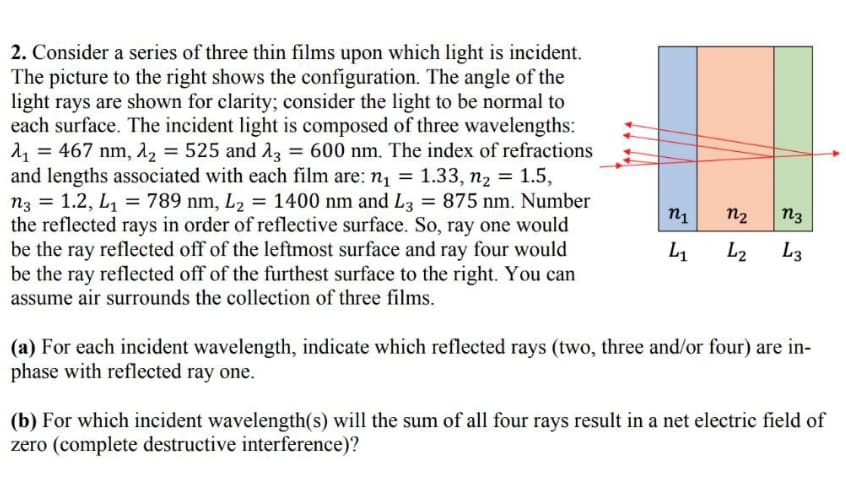2. Consider a series of three thin films upon which light is incident. The picture to the right shows the configuration. The angle of the light rays are shown for clarity; consider the light to be normal to each surface. The incident light is composed of three wavelengths: 4 = 467 nm, 12 = 525 and 13 = 600 nm. The index of refractions and lengths associated with each film are: n1 = 1.33, n2 = 1.5, n3 = 1.2, L1 = 789 nm, L2 = 1400 nm and L3 = 875 nm. Number the reflected rays in order of reflective surface. So, ray one would be the ray reflected off of the leftmost surface and ray four would be the ray reflected off of the furthest surface to the right. You can assume air surrounds the collection of three films. n2 n3 L1 L2 L3 (a) For each incident wavelength, indicate which reflected rays (two, three and/or four) are in- phase with reflected ray one. (b) For which incident wavelength(s) will the sum of all four rays result in a net electric field of zero (complete destructive interference)?
2. Consider a series of three thin films upon which light is incident. The picture to the right shows the configuration. The angle of the light rays are shown for clarity; consider the light to be normal to each surface. The incident light is composed of three wavelengths: 4 = 467 nm, 12 = 525 and 13 = 600 nm. The index of refractions and lengths associated with each film are: n1 = 1.33, n2 = 1.5, n3 = 1.2, L1 = 789 nm, L2 = 1400 nm and L3 = 875 nm. Number the reflected rays in order of reflective surface. So, ray one would be the ray reflected off of the leftmost surface and ray four would be the ray reflected off of the furthest surface to the right. You can assume air surrounds the collection of three films. n2 n3 L1 L2 L3 (a) For each incident wavelength, indicate which reflected rays (two, three and/or four) are in- phase with reflected ray one. (b) For which incident wavelength(s) will the sum of all four rays result in a net electric field of zero (complete destructive interference)?
Related questions
Question

Transcribed Image Text:2. Consider a series of three thin films upon which light is incident.
The picture to the right shows the configuration. The angle of the
light rays are shown for clarity; consider the light to be normal to
each surface. The incident light is composed of three wavelengths:
4 = 467 nm, 12 = 525 and 13 = 600 nm. The index of refractions
and lengths associated with each film are: n1 = 1.33, n2 = 1.5,
n3 = 1.2, L1 = 789 nm, L2 = 1400 nm and L3 = 875 nm. Number
the reflected rays in order of reflective surface. So, ray one would
be the ray reflected off of the leftmost surface and ray four would
be the ray reflected off of the furthest surface to the right. You can
assume air surrounds the collection of three films.
n2
n3
L1
L2
L3
(a) For each incident wavelength, indicate which reflected rays (two, three and/or four) are in-
phase with reflected ray one.
(b) For which incident wavelength(s) will the sum of all four rays result in a net electric field of
zero (complete destructive interference)?
Expert Solution
This question has been solved!
Explore an expertly crafted, step-by-step solution for a thorough understanding of key concepts.
This is a popular solution!
Trending now
This is a popular solution!
Step by step
Solved in 6 steps with 6 images
